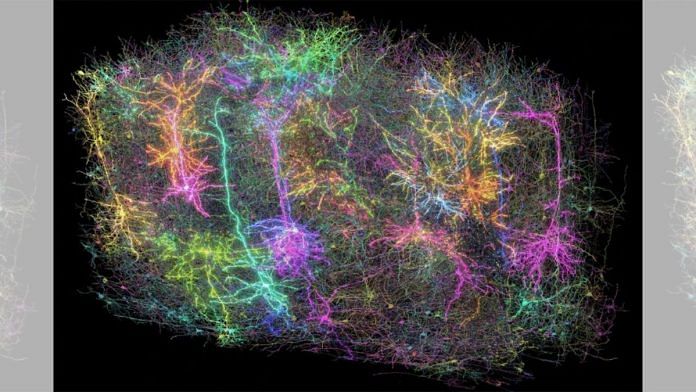New Delhi: Scientists have developed the most accurate map of the mammal brain yet, using just one cubic millimetre of a mouse brain. In what is being called a transformative achievement for neuroscience—equivalent to the Human Genome Project in its scale—the MICrONS Project with over 150 scientists has developed the most detailed map of a mouse brain yet.
This in-depth 3D diagram of one cubic millimetre of the mouse brain has over 200,000 cells and 523 million synapses.
One cubic milimetre is equivalent to about a grain of sand, and might not seem like a lot. But this shows how complicated mammalian brains are and how little is known about them.
With this new map, scientists can now recognise new brain cells, infer new neural networks, and also make advancements in diseases linked to neural communication, including Alzheimer’s, Parkinson’s and autism.
One of the scientists involved in the project described this project as “having access to a Google map” of one cubic millimetre of the brain, allowing them to navigate their way around this complex and essential organ.
Also Read: Why do bats not collide while emerging from caves? German, Israeli researchers have an answer
Russell Viper’s venom changes with climate
A study by scientists from Indian Institute of Science Bengaluru has mapped how different climatic conditions lead to changes in the venom composition of Russell vipers, among the deadliest snakes in the world. If someone gets bitten by a Russell viper in Karnataka versus one in Bhopal, the effect of the venom will be different because of the varying composition.
The reason for this, according to a paper published in PLOS Neglected Tropical Diseases journal, is because of climate factors, like temperature and rainfall. The researchers found that the potency and toxicity of venom in a Russell Viper depends on the kind of climate they live in, thus managing to establish this initial relationship between abiotic factors and snake venom.
Russell vipers are responsible for 40 percent of totally recorded snake bites in India, and a deeper understanding of their venom characteristics is very important to understand how to counter these bites and develop antidotes.
How ancient tools help establish ties among prehistoric humans
The size of a crude tool carved from rocks helped some archaeologists unravel the different ties between groups of prehistoric people. In a paper in the Journal of Paleolithic Archaeology, scientists from the US and South Africa talk about the discovery of stone tools in a cave in South Africa, dating back 20,000 years.
This was the end of the last Ice Age on Earth, and by examining the chips on the blades, and the structure of the tools, archeologists found their core—the original rock from which these tools are made—after which they could tell exactly how the tools were made by being chiseled from the rock.
What they realized is that the process of making these stone tools in South Africa was very similar—in fact identical—to the process used by prehistoric humans in Namibia, which is hundreds of miles away.
Similar processes indicate that these two groups of prehistoric people had connections, and interacted and shared their methodology. It is not just a coincidence. This study showed how there is so much more to discover about the human race and its history.
Milky Seas mystery connected to meteorological phenomena
A team of scientists at the University of Colorado has found an explanation for the milky seas phenomenon. Sailors for years have spoken about a glowy, almost bioluminescent phenomenon in the middle of the ocean, especially in the Indian Ocean and Arabian Sea, which was then given the name milky seas.
While there was some doubt about whether this was caused by luminescent bacteria, like the plankton that light up some beaches in India and Maldives, it wasn’t confirmed. Now, after analysing over 400 years’ worth of data, including eyewitness accounts and satellite images, scientists can confirm that the phenomenon is related to the El Nino and Indian Ocean Dipole meteorological events.
This is a statistical finding, though. What scientists will do now is send out a research vessel to the Indian Ocean at the time when they know they will encounter milky seas, and then try to get a sample and study it. This will give conclusive evidence of how exactly the entire ocean lights up during these times.
(Edited by Mannat Chugh)
Also Read: Earth has far less fresh water available for lithium mining than estimated, US researchers find






